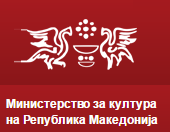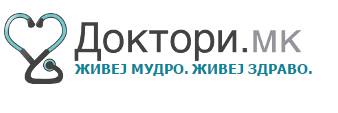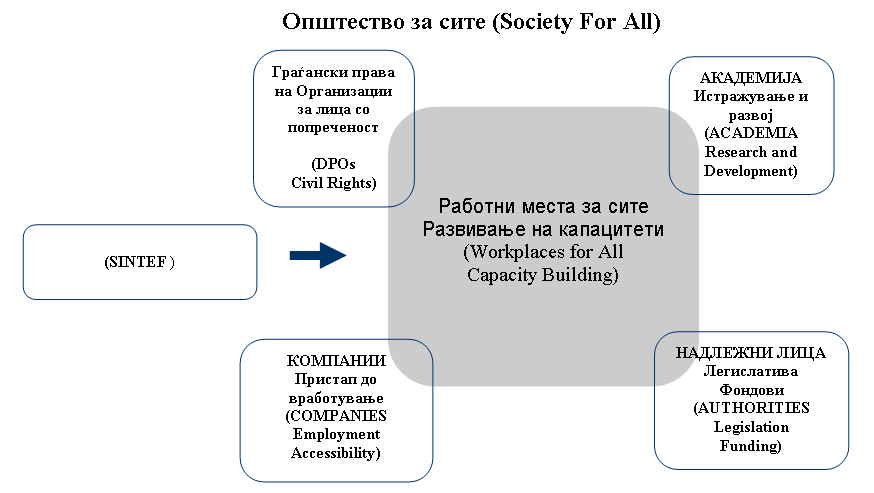JSER Policies
JSER Online
JSER Data
Frequency: quarterly
ISSN: 1409-6099 (Print)
ISSN: 1857-663X (Online)
Authors Info
- Read: 53572
|
„ОПШТЕСТВО ЗА СИТЕ“ ПИЛОТ СТУДИЈА ЗА ВРАБОТУВАЊЕ И РАБОТНИТЕ УСЛОВИ ЗА ЛИЦАТА СО ИНВАЛИДНОСТ ВО МАКЕДОНИЈА
Зора ЈАЧОВА1, Лисбет ГРУТ, Катрине ВАЛСО ЕИДЕ, Геир ТУРМИ2, Александра КАРОВСКА1
Филозофски факултет, |
|
“WORKPLACES FOR ALL” A PILOT STUDY ON EMPLOYMENT AND WORKING CONDITIONS FOR PEOPLE WITH DISABILITIES IN MACEDONIA
Zora JACHOVA1, Lisbet GRUT, Cathrine VALSO EIDE, Geir TYRMI2,Aleksandra KAROVSKA1
Faculty of Philosophy, Department of Special Education and Rehabilitation1 |
|
|
|
|
|
|
|
|
|
Позадина |
|
Background |
|
Работата и можноста за професионална афирмација се важни аспекти од животот на секој човек. Проблемите во врска со вработувањето на лицата со попреченост се многубројни и сложени. Како бариери би ги истакнале: предрасудите на работодавците, оспособувањето за мал број професии, потценувачкиот однос, неповолната социјална положба итн. За тоа зборува и податокот дека ниту во развиените европски земји не е постигната целта за оптимална вработеност кога се во прашање лицата со инвалидитет. Во Европа приближно 44% од сите лица со инвалидитет се вработени, а целта на Европа е тоа да бидат 70%. Кај нас тие проблеми се дополнително комплицирани од општествено-економските околности, технолошките и организационите промени кои ги носи транзиционата економија, ставот на општествената средина за можностите на лицата со попреченост, архитектонските бариери, ниската образовна структура, непостоењето современ центар за практично оспособување, но и ниската мотивираност на лицата со инвалидитет за вклучување во процесот на работа и нивното потпирање на социјалната помош кои секако не се доволни за задоволување елементарни потреби. |
|
Employment and the opportunity for professional affirmation are important aspects of every person’s life. The issues regarding the employment of the people with disabilities are multiple and complex. We would underline the following barriers: prejudice from the employers, qualifications for a trivial number of professions, misjudged attitude, unfavourable social status, etc. This goes together with the fact that not even in the developed European countries, the aim for an optimal employment is not achieved. In Europe nearly 44% of all people with disabilities are employed and the goal of Europe is 70%. |
|
|
|
|
|
Вовед |
|
Introduction |
|
СИНТЕФ, истражување во областа на здравството, од Норвешка, кон крајот на 2005 година покрена иницијатива, за реализација на пилот проект за да се проучи статусот на лицата со инвалидност кои се вработени во заштитните друштва во Република Македонија.
СИНТЕФ, Институтот за дефектологија при Филозофскиот факултет во Скопје и Полио Плус, Македонска организација за лица со попреченост, формираа работна група за подготвување и спроведување на пилот студијата. СИНТЕФ и Фондацијата Отворено Општество на Македонија го ко-финансираа проектот. Во дополнение Министерството за труд и социјална политика на Република Македонија беше покането да партиципира. |
|
SINTEF Health Research, Norway, near the end of 2005, arouse an initiative for realization of a pilot study for examining of the status of the disabled people, employed in the protective companies in Republic of Macedonia.
SINTEF, the Faculty of Philosophy Institute of Special Education and Rehabilitation in Skopje and Polio Plus, a Macedonian Disabled People’s Organisation (DPO), formed a working group to prepare and conduct the pilot study. SINTEF and Foundation Open Society Macedonia (FOSIM) co-financed the project. In addition the Ministry of Labour and Social Policy of Republic of Macedonia was invited to participate. |
|
|
Општество за сите (Society For All)
|
Главни партиципиенти |
|
Main stakeholders |
|
|
|
|
|
|
|
|
Цели |
|
Objectives |
|
|
|
|
|
|
|
|
Пристап |
|
Approach |
|
Квалитативниот истражувачки проект ќе биде спроведен во соработка меѓу професионалците од СИНТЕФ, професионалците од Универзитетот Св. Кирил и Методиј и претставници од НВО Полио Плус. СИНТЕФ истражување во здравството ќе биде одговорен за развој на квалитативната истражувачка методологија во проектот (2). |
|
A qualitative research project was conducted in co-operation between researchers from SINTEF, researchers from University of St. Cyril and Methodius and representatives from the DPO Polio Plus. SINTEF Health Research was responsible for the development of the qualitative research methodology in the project (2). |
|
Квалитативната студија беше генерално насочена кон истражување на работната и животната ситуација на лицата со инвалидност вработени во заштитните друштва во Република Македонија. Следи извештај за нашите резултати. |
|
The qualitative study was generally pointed towards an exploration of the living and working situation of the disabled people employed in the protective companies in Republic of Macedonia. In following we will give a report of our results. |
|
ЗаконскарегулативавоРепубликаМакедонија |
|
Legal regulations in Republic of Macedonia |
|
Ситуацијата на лицата со инвалидност во Македонската работна сила е во голема мера раководена од законот за заштитни компании кој што им дава на компаниите официјални бенефиции за вработување на работници со попреченост. Законите, на лицата со попреченост, им го даваат правото за исти работни услови како и непопречените работници.
Член 5 ги дава следните барања за компаниите:
Член 6 го специфицира обезбедувањето на специјалните фондови:
|
|
The situation for people with disabilities in the Macedonian workforce is largely governed by the law of protective companies that gives the companies official benefits for employing workers with disabilities. The regulations give workers with disabilities the right to the same working conditions as non-disabled workers.
Article 5 follows up with requirements for the companies:
Article 6 specifies the provision of Special Funds:
|
|
Заштитни компании |
|
Protective companies |
|
Согласно член 11 од Законот за вработување на инвалидни лица:
До 2000 година, кога е имплементиран Законот за вработување на инвалидни лица, постоеја претпријатија за професионално оспособување и вработување на инвалиди. Од средината на 2000 година овие претпријатија се пререгистрираа и продолжија да работат како заштитни трговски друштва, под услов да ги исполнуваат погоре наведените услови (наведени во член 11 од Законот за вработување на инвалидни лица).
Средствата за подобрување на условите за вработување и работење на инвалидните лица, адаптација на работното место и набавка на опрема, согласно член 8 од наведениот закон, се обезбедуваат од Посебниот фонд за подобрување на условите за вработување и работење на инвалидните лица (3). |
|
According to article 11, of the Law for employment of disabled persons
Before 2000, when the Law for employment was implemented, there were companies for professional training and employment of persons with disabilities. From the middle of 2000 these companies were re-registered and continued to work as protective trade companies under the condition to fulfil the above mentioned conditions (specified in article 11 of the Law for employment of disabled persons).
The means for improvement of the conditions for employment and work of the disabled persons, the adaptation of the work place and purchase of equipment, according to article 8 of the mentioned Law, are provided from the Special Fund for improvement of the condition for employment and work of the disabled person (3). |
|
Квалитативнаистражувачкаметодологија |
|
Qualitative research methodology |
|
При изборот на проблемот се определивме за контекстуален со цел да дојдеме до информации кои ја опишуваат ситуацијата односно потешкотиите со кои се среќаваат лицата со инвалидност во определен социјален контекст, односно во Република Македонија.
Во оваа фаза од истражувањето беше неопходно да се утврдат и “истражувачкитепрашања” односно да се дефинираат хипотезите со цел да ја определиме рамката за анализа и интерпретација на податоците. Значи, согласно поставените цели на истражувањето ги поставивме следниве истражувачки прашања: |
|
During the selection of the problem we decided on a contextual one, meaning that. the purpose was to gain information that describe the situation, the difficulties that the persons with disability interface in a certain social context, in Republic of Macedonia.
In this phase of the research it was essential to settle on the “the research questions” actually to define the hypothesis with the purpose to determine the frame for analysis and interpretation of the results. The following research questions were set:
During the next phase we decided on exertion of the research method semi structured interview. In the phase of receiving access to the field we interfaced a number of challenges as getting approval from the authorized institutions for realization of our qualitative research. Regarding the current situation we decided on a suitable sample or so called opportunistic sample, that is to choose those respondents that are accessible to us. In the phase of the analyses of the data we used the strategy “coding or categorization”(1). We marked the data and divided them into themes. Through the sum characteristics we defined concepts or typologies. By sorting the statements of the respondents, and by comparing the similarities and differences between them, we wanted to discover the interior dimension of the phenomenon. |
Во текот на следната фаза се определивме за примена на истражувачкиот метод полуструктурирано интервју. Во етапата на собирање на податоците, односно обезбедување пристап на теренот наидовме на низа проблеми како што се обезбедување одобрение од надлежните институции за реализирање на истражувањето и соодветна идентификација на респодентите со цел да добиеме сигнификативни податоци за проблемот на истражување. На тој начин бевме принудени да се определиме за пригоден примерок или таканаречен опортунистички, односно да ги избереме оние испитаници кои ни се достапни. Во фазата на анализа на податоците ја употребивме стратегијата „кодирање или категоризација“ (1). Податоците ги обележавме и разделивме како теми. Преку збировите карактеристики дефиниравме концепти или типологии. Сортирајќи ги исказите на испитаниците, компарирајќи ги сличностите и разликите меѓу нив, сакавме да ги откриеме внатрешните димензии на појавата. |
|
|
|
|
||
|
|
|
|
|
Резултати од истражувањето |
|
Research results |
|
Запознавањето со податоците од истражувањето ни овозможи добивање на генерален впечаток, односно содржина, разновидност и квалитет на податоците. После преслушаните аудио записи и читањето и анализата на транскрипциите направивме селекција на специфичните и репрезентативни податоци.
|
|
The introduction to the research data enables us to gain a general impression, actually the content, variety and quality of the data. After the hearing of the audio transcription and the reading and analysis of the transcriptions we made a selection of the specific and representative data.
|
|
|
|
|
||||
|
Финален заклучок |
|
Final comments |
||
|
Имајќи на ум дека оваа студија е пилот студија и како таква е ограничена, методолошкиот пристап којшто беше прикажан укажува на валидноста на студијата. Пилот студијата ја покажа користа од имањето на партнери од различни организации кои работат заедно во еден истражувачки проект. Различноста на улогите, знаењето и интересите меѓу организација на инвалидни лица која работи како национална група и научничкиот кадар од две култури, без сомнение даде пошироко разбирање на истражуваниот предмет. Резултатите не прикажаа неправилности или неадекватен третман на оваа прилично ранлива група на вработени. Сосем спротивното, постоеше кореспонденција меѓу менаџерите и вработени за повеќе прашања. |
|
Bearing in mind that this study is a pilot study, and as such is limited in scope, the methodological approach that has been followed secure the validity of the study. The pilot has shown the benefit of having partners from different organisations working together in a research project. The diversity of roles, knowledge and interests between a DPO that act as a national pressure group and scientific personal from two cultures, has without doubt given a broader understanding of the subject in question. |
||
|
Меѓутоа треба да биде земен во предвид фактот дека истражувачката група посети само еден ограничен број на компании кои дозволија да бидат посетени, и покажаа позитивен интерес да бидат дел од студијата. Поради ова треба да има причина за да се обележат овие компании како компании со најдобра пракса. Сепак, студијата откри неколку предизвици кои треба подлабоко да се истражат. Меѓу нив се и: употребата на помошна технологија и адаптации, социјалната инклузија во заштитните друштва и во локалната заедница, како и прописите и процесите на добивање на бенифиции од заштитните друштва. |
|
|||
|
|
|
|
||
|
|
|
|
||
|
Citation:Jachova Z, Grut L, Valso Eide C, Tyrmi G, Karovska A. “Workplaces for All” a Pilot Study on Employment and Working Conditions for People with Disabilities in Macedonia. J Spec Educ Rehab 2006; 7(3-4):45-56. |
||||
|
|
||||
|
Literatura / References |
|
|
||
|
|
|
||
Share Us
Journal metrics
-
 SNIP 0.059
SNIP 0.059 -
 IPP 0.07
IPP 0.07 -
 SJR 0.13
SJR 0.13 -
 h5-index 7
h5-index 7 -
 Google-based impact factor: 0.68
Google-based impact factor: 0.68
10 Most Read Articles
- PARENTAL ACCEPTANCE / REJECTION AND EMOTIONAL INTELLIGENCE AMONG ADOLESCENTS WITH AND WITHOUT DELINQUENT BEHAVIOR
- RELATIONSHIP BETWEEN LIFE BUILDING SKILLS AND SOCIAL ADJUSTMENT OF STUDENTS WITH HEARING IMPAIRMENT: IMPLICATIONS FOR COUNSELING
- EXPERIENCES FROM THE EDUCATIONAL SYSTEM – NARRATIVES OF PARENTS WITH CHILDREN WITH DISABILITIES IN CROATIA
- INOVATIONS IN THERAPY OF AUTISM
- AUTISM AND TUBEROUS SCLEROSIS
- THE DURATION AND PHASES OF QUALITATIVE RESEARCH
- REHABILITATION OF PERSONS WITH CEREBRAL PALSY
- DISORDERED ATTENTION AS NEUROPSYCHOLOGICAL COGNITIVE DISFUNCTION
- HYPERACTIVE CHILD`S DISTURBED ATTENTION AS THE MOST COMMON CAUSE FOR LIGHT FORMS OF MENTAL DEFICIENCY
- DIAGNOSTIC AND TREATMENT OPTIONS IN AUTISTIC SPECTRUM DISORDERS – AN OVERVIEW

















